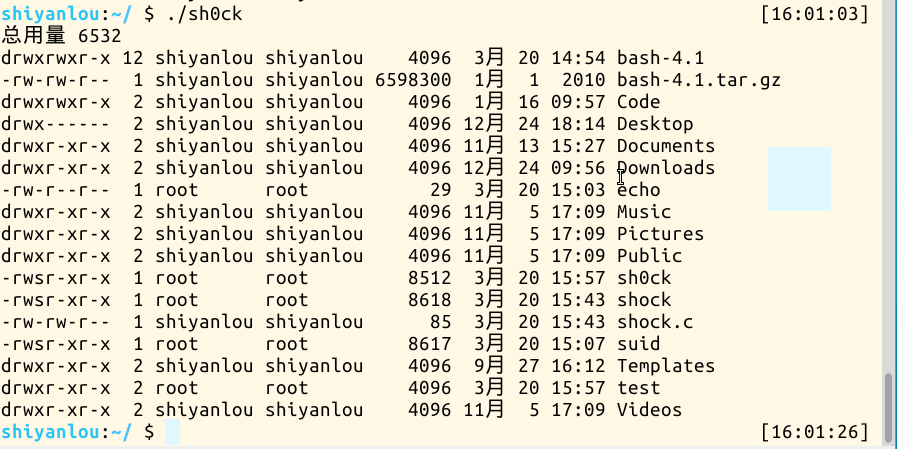SEED实验系列:ShellShock 攻击实验
实验楼课程原文链接:https://www.shiyanlou.com/courses/230,内容能够得到你的喜欢,我们感到非常高兴的,也十分欢迎您分享转载,转载请保留实验楼课程原文链接。
一、 实验描述
2014年9月24日,Bash中发现了一个严重漏洞shellshock,该漏洞可用于许多系统,并且既可以远程也可以在本地触发。在本实验中,学生需要亲手重现攻击来理解该漏洞,并回答一些问题。
二、 预备知识
1. 什么是ShellShock?
Shellshock,又称Bashdoor,是在Unix中广泛使用的Bash shell中的一个安全漏洞,首次于2014年9月24日公开。许多互联网守护进程,如网页服务器,使用bash来处理某些命令,从而允许攻击者在易受攻击的Bash版本上执行任意代码。这可使攻击者在未授权的情况下访问计算机系统。——摘自维基百科
2. 进行实验所需的准备
1. 环境搭建
以root权限安装4.1版bash(4.2版本以上的漏洞已经被堵上了) bash4.1 下载地址:http://ftp.gnu.org/gnu/bash/bash-4.1.tar.gz 
下载
# wget http://ftp.gnu.org/gnu/bash/bash-4.1.tar.gz
安装
# tar xf bash-4.1.tar.gz # cd bash-4.1 # ./configure # make & make install
链接
# rm /bin/bash # ln -s /usr/local/bin/bash /bin/bash
到这里就安装完了,接下来检测是否存在shellshock漏洞。
$ env x=‘() { :;}; echo vulnerable‘ bash -c "echo this is a test "
输出vulnerable的话,说明bash有漏洞。
最后,让/bin/sh 指向/bin/bash.
$ sudo ln -sf /bin/bash /bin/sh
现在一切就绪,进入下一步吧。
2.预备知识
了解bash自定义函数,只需要函数名就能够调用该函数。
$ foo() { echo bar; }
$ foo
> bar
这个时候的Bash的环境变量:
KEY = foo
VALUE = () { echo bar; }
来看看ShellShock漏洞的真身:
export foo=’() { :; }; echo Hello World’
bash
>Hello World
怎么样?看明白了没?为什么调用bash的时候输出Hello World了呢? 瞧瞧他内部的情况:
KEY = foo
VALUE = () { :; }; echo Hello World
bash读取了环境变量,在定义foo之后直接调用了后面的函数。 一旦调用bash,自定义的语句就直接触发。
到了这,你有想到什么么,联系之前的Set-UID课程。 对!干坏事的孩子会被警察叔叔抓走的:)
不多说了,来get root权限吧!
三、 实验内容
1.攻击Set-UID程序
本实验中,我们通过攻击Set-UID程序来获得root权限。 首先,确保安装了带有漏洞的bash版本,并让/bin/sh 指向/bin/bash.
$ sudo ln -sf /bin/bash /bin/sh
请编译下面这段代码,并设置其为Set-UID程序,保证它的所有者是root。我们知道system()函数将调用"/bin/sh -c" 来运行指定的命令, 这也意味着/bin/bash 会被调用,你能够利用shellshock漏洞来获取权限么?
#include <stdio.h>
void main()
{
setuid(geteuid()); // make real uid = effective uid.
system("/bin/ls -l");
}
我们注意到这里使用了setuid(geteuid()) 来使real uid = effective uid,这在Set-UID程序中不是普遍实践,但它确实有时会发生。 先自己试着hack一下:) …… …… …… …… …… …… 以下是hack过程。 
如果 setuid(geteuid()) 语句被去掉了,再试试看攻击,我们还能够拿到权限么?
#include <stdio.h>
void main()
{
system("/bin/ls -l");
}
 (hack过程与step1完全一样,sh0ck是编译后的程序)
(hack过程与step1完全一样,sh0ck是编译后的程序)
失败啦!这就说明如果 real uid 和 effective uid 相同的话,定义在环境变量中的内容在该程序内有效,那样shellshock漏洞就能够被利用了。但是如果两个uid不同的话,环境变量失效,就无法发动攻击了,这可以从bash的源代码中得到印证(variables.c,在308到369行之间)请指出是哪一行导致了这样的不同,并说明bash这样设计的原因。
这里给出这部分代码
/* Initialize the shell variables from the current environment.
If PRIVMODE is nonzero, don‘t import functions from ENV or
parse $SHELLOPTS. */
void
initialize_shell_variables (env, privmode)
char **env;
int privmode;
{
char *name, *string, *temp_string;
int c, char_index, string_index, string_length;
SHELL_VAR *temp_var;
create_variable_tables ();
for (string_index = 0; string = env[string_index++]; )
{
char_index = 0;
name = string;
while ((c = *string++) && c != ‘=‘)
;
if (string[-1] == ‘=‘)
char_index = string - name - 1;
/* If there are weird things in the environment, like `=xxx‘ or a
string without an `=‘, just skip them. */
if (char_index == 0)
continue;
/* ASSERT(name[char_index] == ‘=‘) */
name[char_index] = ‘\0‘;
/* Now, name = env variable name, string = env variable value, and
char_index == strlen (name) */
temp_var = (SHELL_VAR *)NULL;
/* If exported function, define it now. Don‘t import functions from
the environment in privileged mode. */
if (privmode == 0 && read_but_dont_execute == 0 && STREQN ("() {", string, 4))
{
string_length = strlen (string);
temp_string = (char *)xmalloc (3 + string_length + char_index);
strcpy (temp_string, name);
temp_string[char_index] = ‘ ‘;
strcpy (temp_string + char_index + 1, string);
parse_and_execute (temp_string, name, SEVAL_NONINT|SEVAL_NOHIST);
/* Ancient backwards compatibility. Old versions of bash exported
functions like name()=() {...} */
if (name[char_index - 1] == ‘)‘ && name[char_index - 2] == ‘(‘)
name[char_index - 2] = ‘\0‘;
if (temp_var = find_function (name))
{
VSETATTR (temp_var, (att_exported|att_imported));
array_needs_making = 1;
}
else
report_error (_("error importing function definition for `%s‘"), name);
/* ( */
if (name[char_index - 1] == ‘)‘ && name[char_index - 2] == ‘\0‘)
name[char_index - 2] = ‘(‘; /* ) */
}
摘出其中关键部分并简化
void initialize_shell_variables(){
// 循环遍历所有环境变量
for (string_index = 0; string = env[string_index++]; ) {
/*...*/
/* 如果有export过的函数, 在这里定义 */
/* 无法导入在特权模式下(root下)定义的函数 */
if (privmode == 0 && read_but_dont_execute == 0 &&
STREQN (“() {“, string, 4)) {
[...]
// 这里是shellshock发生的地方
// 传递函数定义 + 运行额外的指令
parse_and_execute (temp_string, name,
SEVAL_NONINT|SEVAL_NOHIST);
[...]
} }
就是上述那一行判断逻辑导致了两者的不同,primode即私有模式,要求real uid 与 effective uid保持一致。至于如此设计的原因,小编觉得。。别人家的环境变量自己都不知道内容是些什么,import了也没用吧。。。。小编想的比较天真,你一定有更好的答案:)
至于ShellShock漏洞的防御方法么,快去升级你家Bash啦。
四、 练习
在实验楼环境安步骤进行实验,并截图
您已经完成本课程的所有实验,干的漂亮!
License
本课程所涉及的实验来自Syracuse SEED labs,并在此基础上为适配实验楼网站环境进行修改,修改后的实验文档仍然遵循GNU Free Documentation License。
本课程文档github链接:https://github.com/shiyanlou/seedlab
附Syracuse SEED labs版权声明:
Copyright ? 2014 Wenliang Du, Syracuse University. The development of this document is/was funded by the following grants from the US National Science Foundation: No. 1303306 and 1318814. Permission is granted to copy, distribute and/or modify this document under the terms of the GNU Free Documentation License, Version 1.2 or any later version published by the Free Software Foundation. A copy of the license can be found athttp://www.gnu.org/licenses/fdl.html.
郑重声明:本站内容如果来自互联网及其他传播媒体,其版权均属原媒体及文章作者所有。转载目的在于传递更多信息及用于网络分享,并不代表本站赞同其观点和对其真实性负责,也不构成任何其他建议。






































